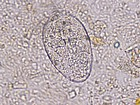Difference between revisions of "Paramphistomum"
Jump to navigation
Jump to search
| (18 intermediate revisions by 3 users not shown) | |||
| Line 1: | Line 1: | ||
| − | {{ | + | {{OpenPagesTop}} |
| − | | | + | {{Taxobox |
| − | | | + | |name = Paramphistomum |
| − | | | + | |kingdom = Animalia |
| − | | | + | |phylum = Platyhelminthes |
| − | | | + | |class = [[:Category:Trematodes|Trematoda]] |
| − | | | + | |sub-class = Digenea |
| + | |order =Echinostomida|sub-order = | ||
| + | |super-family = | ||
| + | |family = Paramphistomatidae | ||
| + | |sub-family = | ||
| + | |genus = Paramphistomum | ||
| + | |species = | ||
| + | }} | ||
| + | ==Introduction== | ||
| + | [[Image:Paramphistomum cervi.jpg|right|150px|thumb|''Paramphistomum cervi'' - Joaquim Castellà Veterinary Parasitology Universitat Autònoma de Barcelona]] | ||
| + | ''Paramphistomum spp'' are of the family ''Paramphistomatidae''. ''Paramphistomomes'' are rare in the UK, but can cause severe losses in ruminants in the wet tropics | ||
| + | |||
| + | The adult fluke is plump and cylindrical (unusual for a [[Trematodes|trematode]]). It attaches to the wall of the rumen without causing serious damage. The eggs are like those of [[Fasciola hepatica|''Fasciola'']], but are colourless, and have long filaments present at the poles. | ||
| + | |||
| + | The intermediate hosts are water snails, and these shed '''cercariae''' which later form '''metacercariae''' on vegetation. | ||
| + | |||
| + | Disease occurs if metacercariae are eaten in large numbers. [[Enteritis]] and [[diarrhoea]] result when immature flukes migrate along the small intestine, (where the metacercariae excyst) towards the rumen. | ||
| + | |||
| + | Also see [[Trematodes - Overview]]. | ||
| + | |||
| + | {{Learning | ||
| + | |flashcards = [[Trematodes_Flashcards|Trematodes Flashcards]] | ||
| + | |literature search = [http://www.cabdirect.org/search.html?rowId=1&options1=AND&q1=Paramphistomum&occuring1=title&rowId=2&options2=AND&q2=&occuring2=freetext&rowId=3&options3=AND&q3=&occuring3=freetext&x=39&y=8&publishedstart=yyyy&publishedend=yyyy&calendarInput=yyyy-mm-dd&la=any&it=any&show=all ''Paramphistomum'' publication] | ||
}} | }} | ||
| − | |||
| − | + | ||
| − | + | {{review}} | |
| − | + | ||
| − | + | {{OpenPages}} | |
| − | + | ||
| − | |||
| − | |||
| − | |||
| − | |||
| − | |||
[[Category:Trematodes]] | [[Category:Trematodes]] | ||
| + | [[Category:Expert_Review - Parasites]][[Category:Cattle Parasites]][[Category:Sheep Parasites]] | ||
Latest revision as of 22:20, 2 August 2012
| Paramphistomum | |
|---|---|
| Kingdom | Animalia |
| Phylum | Platyhelminthes |
| Class | Trematoda |
| Sub-class | Digenea |
| Order | Echinostomida |
| Family | Paramphistomatidae |
| Genus | Paramphistomum |
Introduction
Paramphistomum spp are of the family Paramphistomatidae. Paramphistomomes are rare in the UK, but can cause severe losses in ruminants in the wet tropics
The adult fluke is plump and cylindrical (unusual for a trematode). It attaches to the wall of the rumen without causing serious damage. The eggs are like those of Fasciola, but are colourless, and have long filaments present at the poles.
The intermediate hosts are water snails, and these shed cercariae which later form metacercariae on vegetation.
Disease occurs if metacercariae are eaten in large numbers. Enteritis and diarrhoea result when immature flukes migrate along the small intestine, (where the metacercariae excyst) towards the rumen.
Also see Trematodes - Overview.
| Paramphistomum Learning Resources | |
|---|---|
 Test your knowledge using flashcard type questions |
Trematodes Flashcards |
 Search for recent publications via CAB Abstract (CABI log in required) |
Paramphistomum publication |
| This article has been peer reviewed but is awaiting expert review. If you would like to help with this, please see more information about expert reviewing. |
Error in widget FBRecommend: unable to write file /var/www/wikivet.net/extensions/Widgets/compiled_templates/wrt693e755f87e8c7_38600024 Error in widget google+: unable to write file /var/www/wikivet.net/extensions/Widgets/compiled_templates/wrt693e755f9480e7_61547329 Error in widget TwitterTweet: unable to write file /var/www/wikivet.net/extensions/Widgets/compiled_templates/wrt693e755fa28c32_29972257
|
| WikiVet® Introduction - Help WikiVet - Report a Problem |
